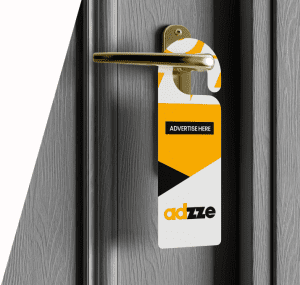In today’s marketing ecosystem, where consumer preferences are shifting toward conscious consumption, sustainability has become a vital part of any brand’s narrative. As marketers seek out eco-friendly strategies that maintain impact without compromising the planet, door ads are undergoing a green transformation. Once dismissed as wasteful or outdated, door hanger ads are now being reimagined with sustainable materials, eco-conscious design, and mindful distribution methods.
This blog offers a comprehensive guide to making your door ad campaigns environmentally responsible without losing their edge. If you’re a marketing professional looking to future-proof your campaigns, this is your playbook.
Why Sustainability in Door Ads Matters More Than Ever
Modern consumers care about environmental responsibility. According to Nielsen, nearly 73% of global consumers say they would definitely or probably change their consumption habits to reduce their environmental impact.
Door hanger ads, when executed without sustainability in mind, can contribute to paper waste, chemical runoff, and unnecessary carbon emissions. But when brands invest in eco-friendly door ads, they:
Build stronger relationships with environmentally conscious audiences
Differentiate themselves in crowded markets
Demonstrate corporate social responsibility
Lower long-term costs through better efficiency
Let’s explore how your brand can adopt greener door hanger ad practices from design to delivery.
Are you curious to see if this works for you? See our Door Hanger Advertising solutions!
Greener Materials for Door Ads
The first step to making your door ads sustainable is choosing the right materials. Paper remains the most common medium for door hanger ads, and luckily, it’s one of the easiest to make eco-friendly.
Recycled Paper
Choose 100% post-consumer recycled paper. It reduces landfill waste and demands less energy and water in the production process.
FSC-Certified Paper
The Forest Stewardship Council (FSC) ensures that paper products come from responsibly managed forests. Including the FSC logo on your door hanger ad sends a powerful message about your brand’s values.
Biodegradable or Seed-Embedded Paper
An innovative take on door ads, seed paper allows consumers to plant the ad once they’ve read it. It’s a literal symbol of growth for eco-conscious campaigns.
 Sustainable Inks and Coatings
Sustainable Inks and Coatings
Toxic inks can undermine the sustainability of your door ads even if you’re using recycled paper.
Soy-Based Inks
Compared to petroleum-based inks, soy ink produces brighter colors, is easier to remove in recycling processes, and is non-toxic.
Water-Based Coatings
Avoid UV or plastic-based coatings and opt for water-based options. These still offer protection without adding non-biodegradable layers.
Eco-Conscious Design Principles for Door Hanger Ads
A truly sustainable door hanger ad isn’t just about what it’s printed on—it’s about how it’s designed.
Minimalist Layouts
Design with purpose. Less ink, fewer colors, and cleaner layouts not only look modern but also use fewer resources.
Dual-Use Messaging
Add more value with less waste. Turn your door ad into a coupon, event ticket, or bookmark to extend its lifecycle.
QR Codes and Digital Bridges
Incorporate QR codes that direct users to more information online. This reduces the need for large volumes of text and additional printed materials.
 Green Distribution Strategies for Door Ads
Green Distribution Strategies for Door Ads
Sustainable distribution is just as important as sustainable printing.
Walkable Routes and Local Teams
Reduce carbon emissions by hiring local distribution teams who can reach target zones by walking or biking rather than driving.
Smart Targeting
Use data analytics and geofencing to target high-conversion areas. Fewer printed door hanger ads will be needed if they’re placed more strategically.
Zero-Waste Delivery Kits
If working with third-party distributors, request packaging-free or reusable delivery kits for your door hanger ads.
Measuring the Environmental Impact of Your Door Ads
Sustainability is a strategy—one that should be measured like any other.
Carbon Footprint Calculators
Use online tools to estimate the carbon output of your door ad campaign, from printing to delivery.
Material Tracking
Track what percentage of your materials are recycled, biodegradable, or responsibly sourced.
Consumer Feedback
Incorporate feedback forms via QR codes to assess consumer response to your green messaging. Many buyers appreciate knowing that brands are making an effort.
Case Study: Eco-Friendly Door Ads in Action
GreenSprout Landscaping, a regional brand, shifted to 100% recycled paper and soy ink for their seasonal door hanger ad campaign. They paired this with:
QR codes for service booking
Distribution within 10-mile walking zones
A discount for customers who recycled the flyer
Results:
25% increase in customer engagement
18% lower production cost over 3 months
Positive media attention and social shares due to the brand’s eco-innovation
The Future of Door Ads: Circular Marketing
Looking ahead, the most successful door hanger ads will be part of circular marketing systems—campaigns designed to be reused, repurposed, and recycled. Whether you’re distributing a door ad embedded with seeds or printing on reusable cloth hangers, the key is reducing impact while maximizing reach.
Final Thoughts: Door Ads Can Be Both Impactful and Sustainable
Door hanger ads have long been a trusted tool for local marketing, and now, they’re becoming a leader in sustainable outreach. By rethinking materials, adopting green design, and reimagining distribution, marketers can turn every door hanger ad into an environmentally conscious conversation starter.
If your brand is ready to lower its footprint and raise its impact, it’s time to go green with your next door ad campaign.


 Sustainable Inks and Coatings
Sustainable Inks and Coatings Green Distribution Strategies for Door Ads
Green Distribution Strategies for Door Ads



